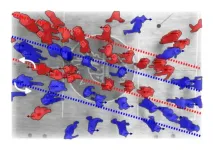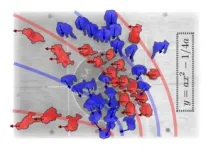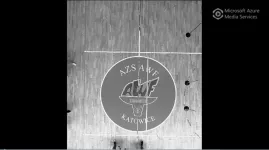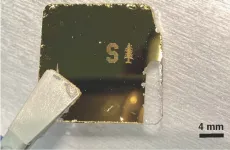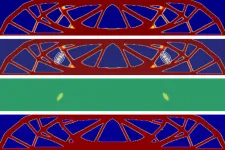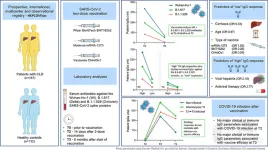(Press-News.org) Have you ever wondered how pedestrians ‘know’ to fall into lanes when they are moving through a crowd, without the matter being discussed or even given conscious thought?
A new theory developed by mathematicians at the University of Bath in the UK led by Professor Tim Rogers explains this phenomenon, and is able to predict when lanes will be curved as well as straight. The theory can even describe the tilt of a wonky lane when people are in the habit of passing on one side rather than the other (for instance, in a situation where they are often reminded to ‘pass on the right’).
This mathematical analysis unifies conflicting viewpoints on the origin of lane formation, and it reveals a new class of structures that in daily life may go unnoticed. The discovery, reported this week (Friday, March 3) in the prestigious journal Science, constitutes a major advance in the interdisciplinary science of ‘active matter’ – the study of group behaviours in interacting populations ranging in scale from bacteria to herds of animals.
Tested in arenas
To test their theory, the researchers asked a group of volunteers to walk across an experimental arena that mimicked different layouts, with changes to entrance and exit gates.
One arena was set up in the style of King’s Cross Station in London. When the researchers looked at the video footage from the experiment, they observed mathematical patterns taking shape in real life.
Professor Rogers said: “At a glance, a crowd of pedestrians attempting to pass through two gates might seem disorderly but when you look more closely, you see the hidden structure. Depending on the layout of the space, you may observe either the classic straight lanes or more complex curved patterns such as ellipses, parabolas, and hyperbolas”.
Lane formation
The single-file processions formed at busy zebra crossings are only one example of lane formation, and this study is likely to have implications for a range of scientific disciplines, particularly in the fields of physics and biology. Similar structures can also be formed by inanimate molecules, such as charged particles or organelles in a cell.
Until now, scientists have given several different explanations for why human crowds and other active systems naturally self-organise into lanes, but none of these theories have been verified. The Bath team used a new analytical approach, inspired by Albert Einstein’s theory of Brownian motion, which makes predictions that can be tested.
Encouraged by the way their theory agreed with the numerical simulations of colliding particles, they then teamed up with Professor Bogdan Bacik – an experimentalist from the Academy of Physical Education in Katowice, Poland – and ran a series of experiments (such as the one modelled on King’s Cross) using human crowds.
Lead author Dr Karol Bacik said: “Lane formation doesn’t require conscious thought – the participants of the experiment were not aware that they had arranged themselves into well-defined mathematical curves.
“The order emerges spontaneously when two groups with different objectives cross paths in a crowded space and try to avoid crashing into each other. The cumulative effect of lots of individual decisions inadvertently results in lanes forming.”
The researchers also tested the effects of externally imposed traffic rules – namely, they instructed the participants to pass others on the right. In agreement with the theoretical prediction, adding this rule changed the lane structure.
“When pedestrians have a preference for right turns, the lanes end up tilting and this introduces frustration that slows people down,” said Dr Bacik.
“What we’ve developed is a neat mathematical theory that forecasts the propensity for lane formation in any given system,” said Professor Rogers, adding: “We now know that much more structure exists than previously thought.”
END
Stick to your lane: Hidden order in chaotic crowds
Mathematical research from the University of Bath in the UK brings new understanding of crowd formation and behaviour
2023-03-02
ELSE PRESS RELEASES FROM THIS DATE:
Crowdsourced reports can quickly identify an earthquake’s impact
2023-03-02
Within minutes, a statistical model based on a global database of public reports of ground shaking can be used to identify an earthquake as a high- or low-impact event, according to a new study published in The Seismic Record.
High-impact earthquakes, as defined by the study, are those associated with at least one destroyed building, at least 50 damaged buildings, at least two deaths, or any documented financial losses.
The researchers were able to provide impact results for 393 global earthquake events from 2021 within 10 minutes. Their model was developed using more than 1.5 million globally collected felt ...
Ocean surface tipping point could accelerate climate change
2023-03-02
The oceans help to limit global warming by soaking up carbon dioxide emissions. But scientists have discovered that intense warming in the future could lessen that ability, leading to even more severe warming.
The discovery comes from a study led by The University of Texas at Austin in which researchers analyzed a climate simulation configured to a worst-case emissions scenario and found that the oceans’ ability to soak up carbon dioxide (CO2) would peak by 2100, becoming only half as efficient at absorbing the greenhouse gas by 2300.
The decline happens because of the emergence of a surface layer of low-alkalinity water ...
DRI announces space education trainings for Nevada teachers
2023-03-02
DRI is pleased to announce “Space Education Educator Professional Development Training,” available for 80 educators. The training will be conducted in Las Vegas and Reno by four Nevada educators who were selected to attend the NASA Space Exploration Educators Conference in Houston in February. In addition to touring NASA facilities, the conference provided hands-on training in lesson plans and activities, and these educators will use the knowledge they gained to teach Nevada teachers.
“DRI is pleased to offer NASA-approved space education training to ...
Stanford researchers develop a new way to identify bacteria in fluids
2023-03-02
Shine a laser on a drop of blood, mucus, or wastewater, and the light reflecting back can be used to positively identify bacteria in the sample.
“We can find out not just that bacteria are present, but specifically which bacteria are in the sample – E. coli, Staphylococcus, Streptococcus, Salmonella, anthrax, and more,” said Jennifer Dionne, an associate professor of materials science and engineering and, by courtesy, of radiology at Stanford University. “Every microbe has its own unique optical fingerprint. It’s like the genetic and proteomic code scribbled ...
Integrating humans with AI in structural design
2023-03-02
Modern fabrication tools such as 3D printers can make structural materials in shapes that would have been difficult or impossible using conventional tools. Meanwhile, new generative design systems can take great advantage of this flexibility to create innovative designs for parts of a new building, car, or virtually any other device.
But such “black box” automated systems often fall short of producing designs that are fully optimized for their purpose, such as providing the greatest strength in proportion to weight or minimizing the amount of ...
Foundation for anesthesia education and research establishes endowed NAM fellowship
2023-03-02
CHICAGO – The Foundation for Anesthesia Education and Research (FAER) announced it has established an endowed National Academy of Medicine (NAM) fellowship to provide early-career anesthesiology scholars with the opportunity to experience and participate in committee, workshop, and roundtable activities of NAM and the National Academy of Sciences (NAS).
Offering a robust catalogue of research grants and programs for early-career anesthesiology investigators, FAER – an American Society of Anesthesiologists’ foundation – is always exploring new avenues of support for up-and-coming researchers. The NAM Fellowship Program was recognized as one such ...
Liver cirrhosis is associated with a lower immune response to COVID-19 vaccines but not with reduced vaccine efficacy
2023-03-02
Amsterdam, March 2, 2023 – The overall responsiveness of patients with chronic liver disease (CLD) to COVID-19 vaccines has been shown to be decreased in patients with cirrhosis. A new prospective study in JHEP Reports, published by Elsevier, now shows that this lower response is observed up to six months following two-dose COVID-19 mRNA vaccination, but it does not reduce vaccine efficacy.
In this prospective study, more than 350 patients with CLD were recruited in clinical centers from Austria, Belgium, Italy, Portugal, Romania, and Spain. Cirrhosis, alongside age and vaccine ...
Human norovirus GII.4 exploits unexpected entry mechanism to cause gastroenteritis
2023-03-02
Human noroviruses are the leading cause of acute gastroenteritis worldwide, a major global health problem for which there are no specific treatments or vaccines. Understanding the first phase of infection – the process the virus follows to invade cells – is a decisive step in the development of effective preventive and therapeutic strategies. A team led by researchers at Baylor College of Medicine is making strides in that direction.
The researchers report in the journal Nature Communications that the globally dominant human norovirus GII.4 strain invades gastrointestinal cells via an unexpected mechanism. The viral strategy involves interactions ...
AI predicts cancer patient survival by reading doctor's notes
2023-03-02
A team of researchers from the University of British Columbia and BC Cancer have developed an artificial intelligence (AI) model that predicts cancer patient survival more accurately and with more readily available data than previous tools.
The model uses natural language processing (NLP) – a branch of AI that understands complex human language – to analyze oncologist notes following a patient’s initial consultation visit—the first step in the cancer journey after diagnosis. By identifying characteristics unique to each ...
For older adults, every 500 additional steps taken daily associated with lower heart risk
2023-03-02
Research Highlights:
A study of people ages 70 and older found walking an additional 500 steps per day, or an additional quarter mile of walking, was associated with a 14% lower risk of heart disease, stroke or heart failure.
Compared to adults who took less than 2,000 steps per day, adults who took about 4,500 steps per day had a 77% lower observed risk of experiencing a cardiovascular event.
Only about 3.5% of participants who took around 4,500 steps per day had a cardiovascular event, compared to 11.5% of those who took less than 2,000 steps per day, over the 3.5-year follow-up period.
Embargoed until 10:45 a.m. CT/11:45 a.m. ET, ...
LAST 30 PRESS RELEASES:
Kids’ behavioral health is a growing share of family health costs
Day & night: Cancer disrupts the brain’s natural rhythm
COVID-19 vaccination significantly reduces risk to pregnant women and baby
The role of vaccination in maternal and perinatal outcomes associated with COVID-19 in pregnancy
Mayo Clinic smartwatch system helps parents shorten and defuse children's severe tantrums early
Behavioral health spending spikes to 40% of all children’s health expenditures, nearly doubling in a decade
Digital cognitive behavioral treatment for generalized anxiety disorder
Expenditures for pediatric behavioral health care over time and estimated family financial burden
Air conditioning in nursing homes and mortality during extreme heat
The Alps to lose a record number of glaciers in the next decade
What makes a good proton conductor?
New science reporting guide published for journalists in Bulgaria
New international study reveals major survival gaps among children with cancer
New science reporting guide published for journalists in Turkey
Scientists develop a smarter mRNA therapy that knows which cells to target
Neuroanatomy-informed brain–machine hybrid intelligence for robust acoustic target detection
Eight SwRI hydrogen projects funded by ENERGYWERX
The Lundquist Institute and its start-up company Vitalex Biosciences Announces Strategic Advancement of Second-Generation fungal Vaccine VXV-01 through Phase 1 Trials under $40 Million Competitive Con
Fine particles in pollution are associated with early signs of autoimmune disease
Review article | Towards a Global Ground-Based Earth Observatory (GGBEO): Leveraging existing systems and networks
Penn and UMich create world’s smallest programmable, autonomous robots
Cleveland researchers launch first major study to address ‘hidden performance killer’ in athletes
To connect across politics, try saying what you oppose
Modulating key interaction prevents virus from entering cells
Project explores barriers to NHS career progression facing international medical graduates
Jeonbuk National University researchers explore the impact of different seasonings on the flavor perception of Doenjang soup
Two Keck Medicine of USC Hospitals named Leapfrog Top Teaching Hospitals
World-first discovery uncovers how glioblastoma tumours dodge chemotherapy, potentially opening the door to new treatments
A fatal mix-up: How certain gut bacteria drive multiple sclerosis
New AI tool identifies not just genetic mutations, but the diseases they may cause
[Press-News.org] Stick to your lane: Hidden order in chaotic crowdsMathematical research from the University of Bath in the UK brings new understanding of crowd formation and behaviour
